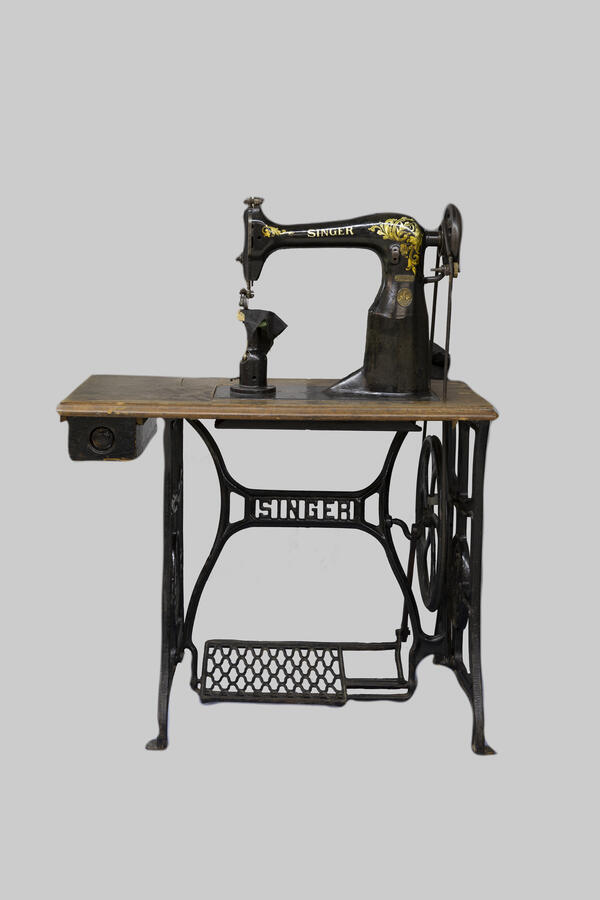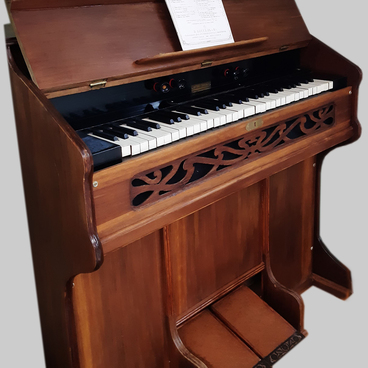The exhibition showcases a treadle sewing machine for sewing leather footwear. It was made by the Singer company. The manufacturer’s seal and a serial number above it can be found on the sewing machine stand. A factory of Singer Manufacturing Company was located in the city of Podolsk in the Russian Empire. After nationalization, the factory was renamed Gosshveymash.
The first project of a sewing machine was suggested by the artist and scientist Leonardo da Vinci in the late 15th century. However, it was not implemented. The German inventor Charles Wiesenthal was awarded the patent for a sewing machine imitating hand-made stitches in 1755. Later, a sewing machines for making footwear was invented in the UK. However, these machines were not widely used.
In 1845, the American mechanical engineer Elias Howe created the first almost usable machine making double seams and 300 stitches per minute. Though, a patent for the invention was acquired in the UK, the USA is considered the homeland of the sewing machine. Isaac M. Singer and his partner established the I. M. Singer & Co. company in New York in 1851. He also opened a sewing machine factory in New Jersey.
The Russian Singer Manufacturing Company joint-stock company appeared in 1896. It was renamed Singer Company in Russia in 1901. It was decided to launch own factory in Russia. The city of Podolsk was chosen. The company acquired a land plot there in summer 1900 and started constructing the factory. Sewing machines were sold in over 3,000 branded stores overall Russian Empire. Buyers could pay for a sewing machine by instalments there.
The exposed sewing machine was used in the city of Sarapul in the early 20th century. From the 18th century, the city was famous for footwear production. People eagerly bought Sarapul-made footwear because boots were durable, while women’s shoes were elegant. In 1912, 16 tanneries operated in the city. They manufactured up to two million pairs of shoes per year. Sarapul ranked second by footwear production in Russia behind the KImrsky Uyezd (administrative territorial unit) of the Tver Governorate. Leather and footwear production remained the main industry of the city until the Revolution of 1917.
The first project of a sewing machine was suggested by the artist and scientist Leonardo da Vinci in the late 15th century. However, it was not implemented. The German inventor Charles Wiesenthal was awarded the patent for a sewing machine imitating hand-made stitches in 1755. Later, a sewing machines for making footwear was invented in the UK. However, these machines were not widely used.
In 1845, the American mechanical engineer Elias Howe created the first almost usable machine making double seams and 300 stitches per minute. Though, a patent for the invention was acquired in the UK, the USA is considered the homeland of the sewing machine. Isaac M. Singer and his partner established the I. M. Singer & Co. company in New York in 1851. He also opened a sewing machine factory in New Jersey.
The Russian Singer Manufacturing Company joint-stock company appeared in 1896. It was renamed Singer Company in Russia in 1901. It was decided to launch own factory in Russia. The city of Podolsk was chosen. The company acquired a land plot there in summer 1900 and started constructing the factory. Sewing machines were sold in over 3,000 branded stores overall Russian Empire. Buyers could pay for a sewing machine by instalments there.
The exposed sewing machine was used in the city of Sarapul in the early 20th century. From the 18th century, the city was famous for footwear production. People eagerly bought Sarapul-made footwear because boots were durable, while women’s shoes were elegant. In 1912, 16 tanneries operated in the city. They manufactured up to two million pairs of shoes per year. Sarapul ranked second by footwear production in Russia behind the KImrsky Uyezd (administrative territorial unit) of the Tver Governorate. Leather and footwear production remained the main industry of the city until the Revolution of 1917.



